If you’re on the hunt for a fuss-free, simple to care for but oh-so-pretty houseplant, you might like to try peperomias.
These little tropical beauties are semi-succulent, and they don’t like lots of sun. In other words, they are perfect for growing in an indoor environment.
But if you’ve looked into peperomias at all already, you’ve probably noticed that there are a ton of different ones out there.
Peperomias belong to the pepper family. In fact, that’s what their botanical name means. Peper translates to “pepper,” and omia means “same.” In other words: similar to pepper.
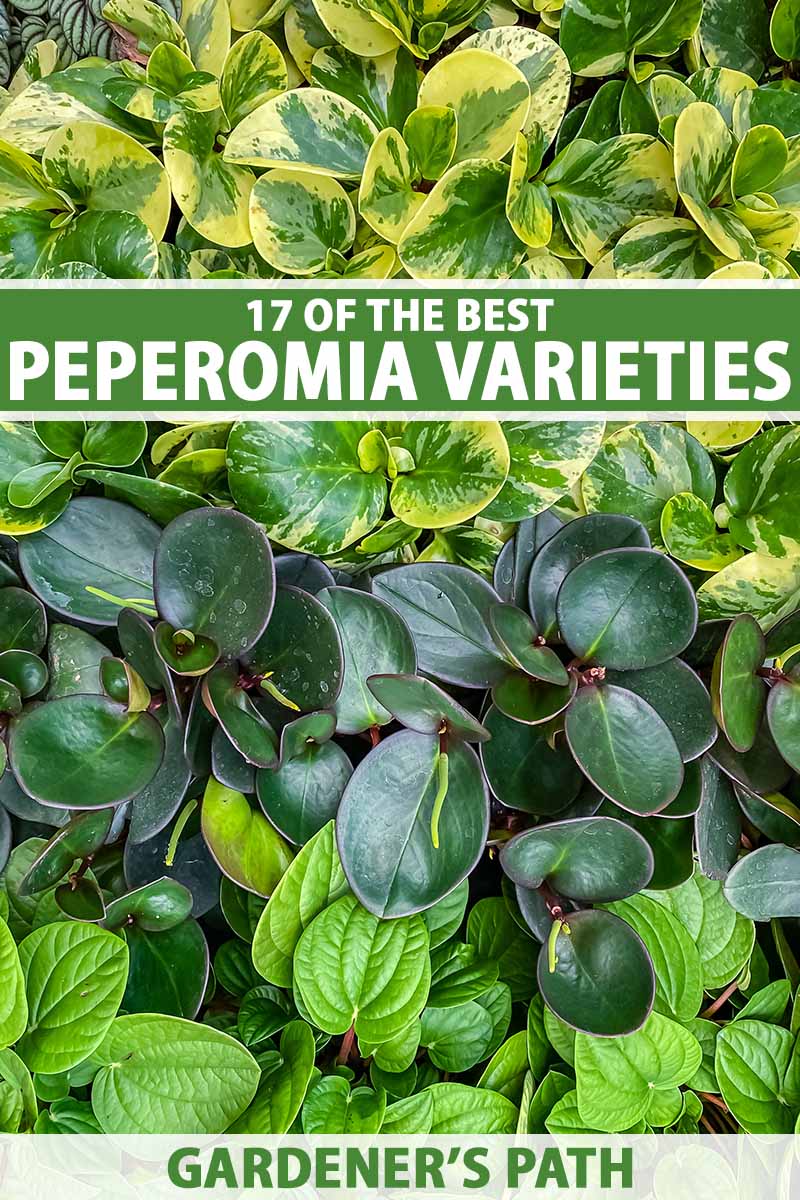
We link to vendors to help you find relevant products. If you buy from one of our links, we may earn a commission.
There are hundreds of Peperomia species, but only a few dozen are commonly grown as houseplants or in home gardens.
Many are epiphytes, which means they don’t grow in soil in nature, but rather, on the trunks and branches of other plants.
Don’t worry, they grow just fine in soil as houseplants, so long as you don’t smother the roots in heavy clay or by adding too much water.
In this guide, we’ll cover 17 of the most common species to grow as houseplants so you can get to know these plants a little better. Here’s what you can expect:
17 Peperomia Species to Grow as Houseplants
Without further ado, let’s meet some peperomias!
1. Alata
With its dark green foliage extending off of graceful stems, it’s no wonder the winged peperomia (P. alata) has soared its way into many homes.
Its common name comes from the inconspicuous winged nodes that extend out of the stem, but what makes this plant stand out are the long, glossy, dark green leaves.
This species is epiphytic, and reaches about a foot tall at maturity. It is native to Jamaica, Mexico, the West Indies, and in the US it grows wild in Florida, where it is endangered.
Be sure to purchase P. alata plants from reputable, nursery-grown sources rather than those that may have been illegally poached from the wild.
2. Angulata
Known as beetle peperomia, this is one of the most common species grown as a houseplant or in the home garden. You can easily see how it was given its name when you look at the foliage.
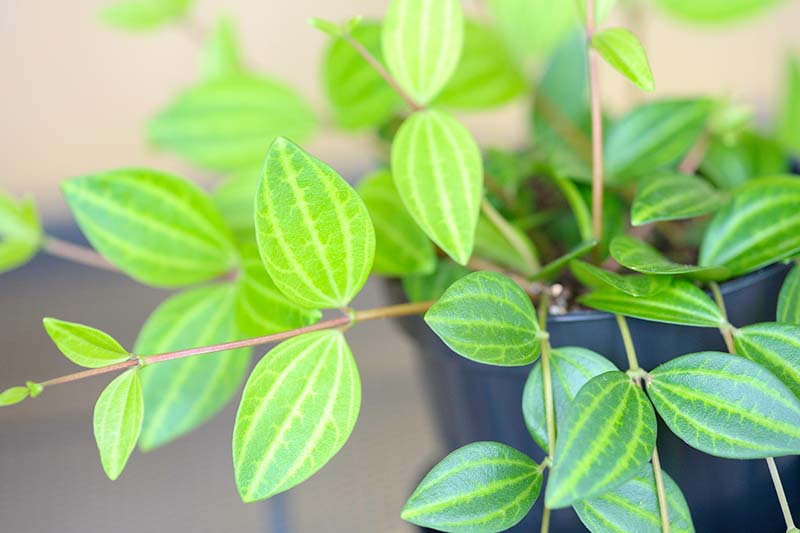
The leaves are small, oval, and dark green with distinct veins that stand out with their bright green coloring. They really do resemble little beetles.
An epiphyte that’s native to the rainforests of South America, P. angulata has a trailing habit with branches that can reach a foot long.
3. Argyreia
Watermelon peperomia, or watermelon begonia, as this one is also called, is not only one of the most common houseplants in this genus, but perhaps one of the most recognizable as well.
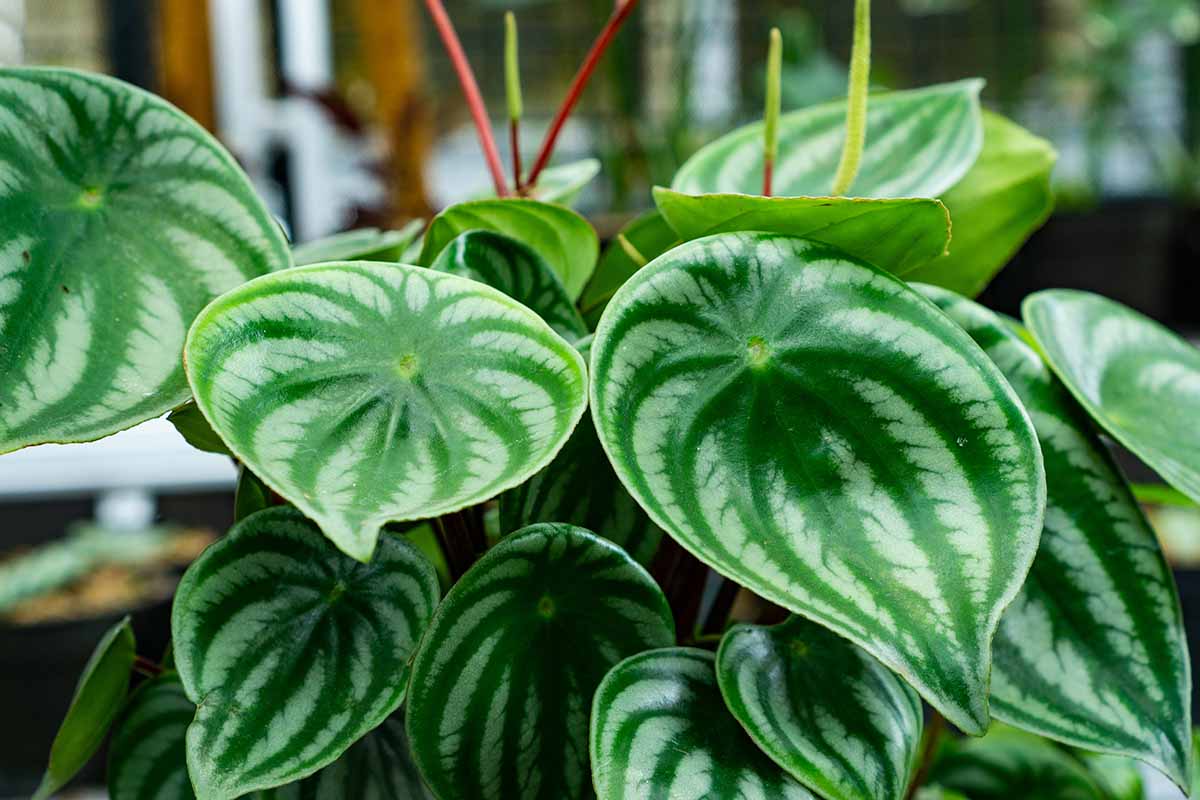
The waxy leaves of P. argyreia look distinctly like a watermelon rind, with a dark green base and grayish-green stripes.
This epiphyte has a rosette growth habit and the petioles (stems) are reddish, serving as a nice contrast to the leaves.
This South American native never grows much taller than nine inches or so, and it actually prefers that its roots be a bit constricted.
That makes it perfect if you’re looking for a plant that can hang out in a small spot like on your bookshelf, desk, or top of the kitchen cabinet.
Bring this beautiful species home in a three- or four-inch pot, available via Amazon.
4. Blanda
The variety of this species you see most often in homes and landscaping is known scientifically as P. blanda var. floribunda, but most people just call this plant the arid or hairy peperomia.
In Hawaii, where it is indigenous, all plants in this genus are called Alaala Wai Nui.
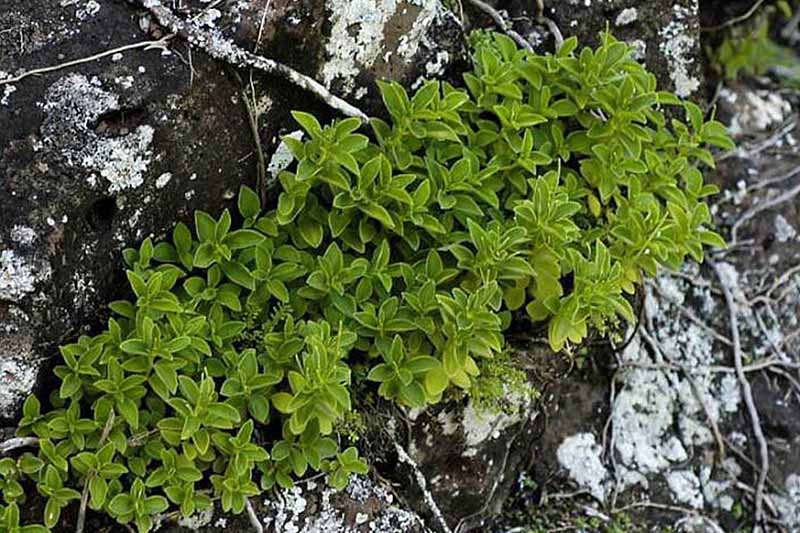
This species has small leaves and stays under a foot tall. It’s a semi-succulent epiphyte with small, medium green leaves.
5. Caperata
Commonly known as emerald ripple, green ripple, little fantasy, or rosso, whatever you call it, this popular peperomia is a stand-out thanks to its deeply rippled and ridged, velvety gray-green leaves.
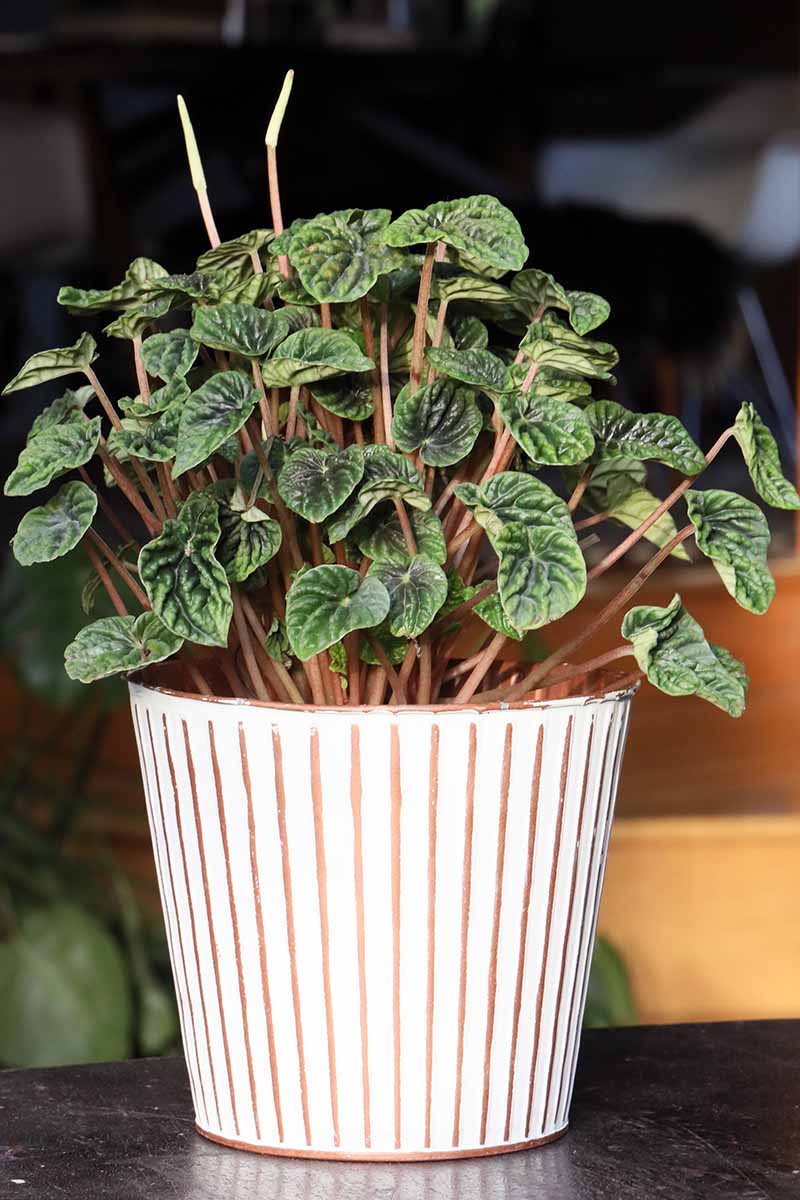
P. caperata is another petite species, rarely growing beyond nine inches tall, with a mounding habit.
Also an epiphyte that is native to South America, it does well with compacted roots that never experience standing water.
6. Clusiifolia
The good old jelly plant isn’t always identified by houseplant lovers as a peperomia because it doesn’t look much like its cousins.
In fact, it can be mistaken for a rubber plant, and I’ve even seen them mislabeled this way at a nursery.
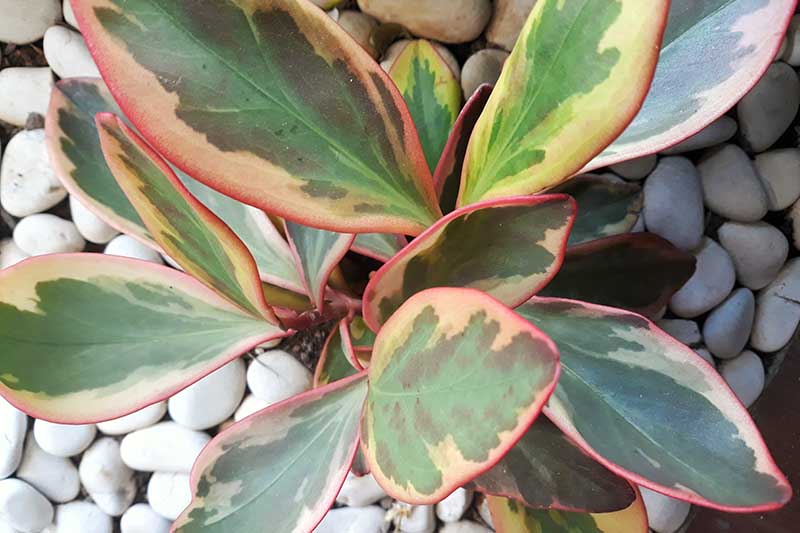
It shouldn’t come as a surprise, then, that P. clusiifolia goes by the common name baby rubber plant.
Also known as red-edged peperomia, these plants have thick, semi-succulent leaves in cream and light green, with pink on the edges. They stay under a foot tall and have a bushier growth habit than a rubber plant.
These are native to parts of Florida, Mexico, the Caribbean, and northern South America.
7. Graveolens
Hailing from Ecuador, P. graveolens highlights the diversity of this genus because it looks more like the succulent it is than the ripple or watermelon species. It has thick, glossy green leaves with red edges, undersides, and stems.
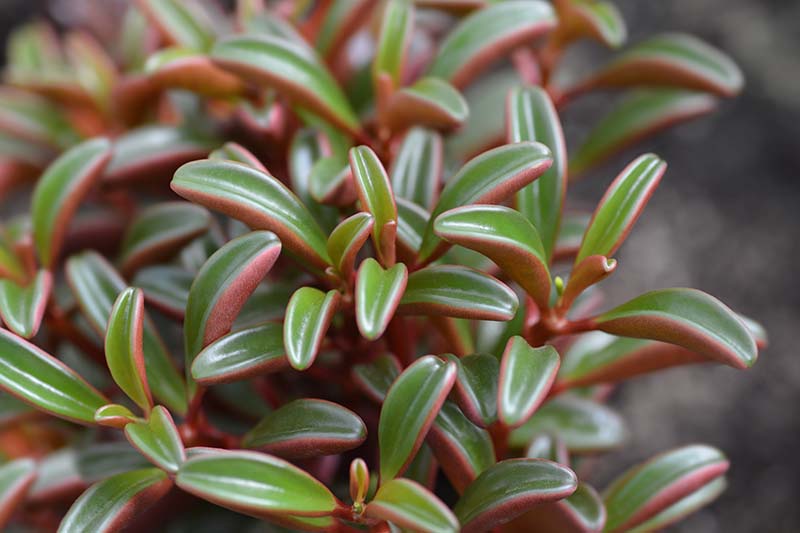
Unlike other succulents, and like most other plants in this genus, it doesn’t do well in direct sunlight. It won’t grow taller than 10 inches and has a lovely mounding growth habit.
This is a terrestrial peperomia and it prefers sandy, loose soil.

Nab a three-inch container of this beauty from Hirt’s Gardens via Amazon.
8. Griseoargentea
Ivy leaf, as P. griseoargentea is also known, has silvery-green and extremely glossy leaves that form in a rosette pattern. This species is native to Brazil.
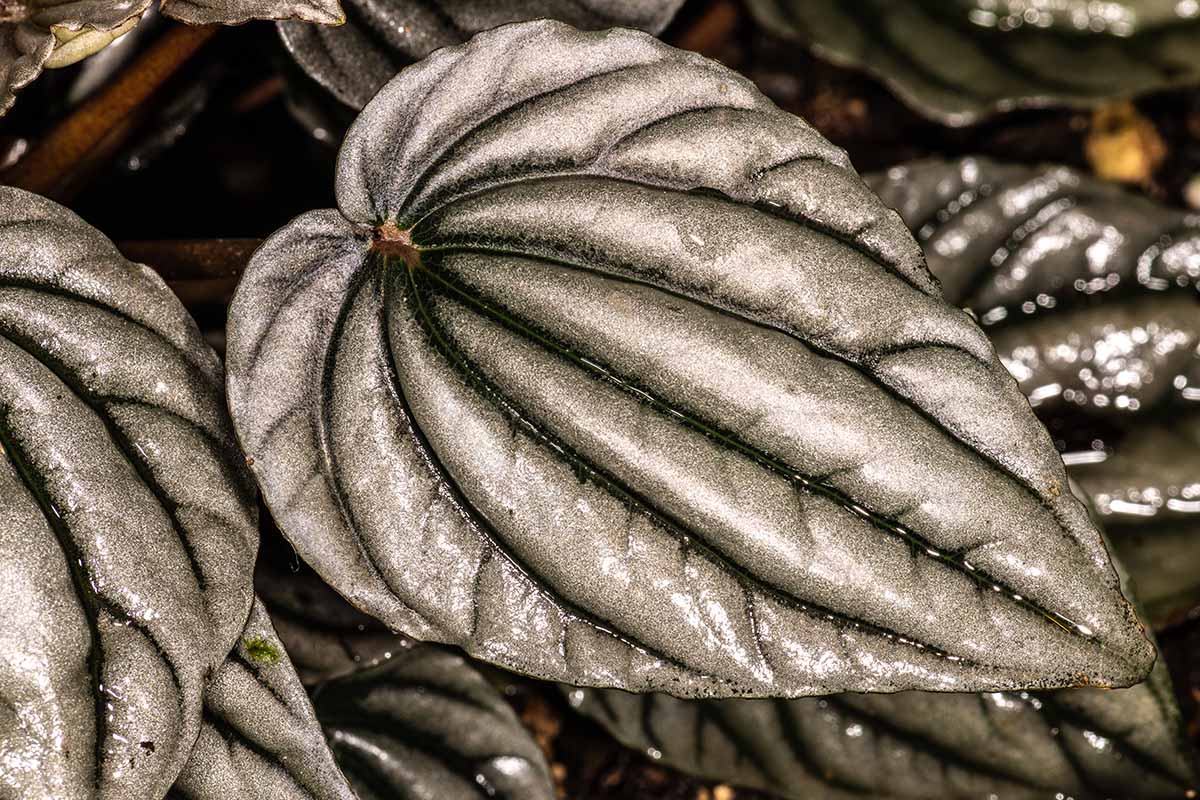
This epiphyte is ideal as a desk plant or on a bookshelf because it rarely grows any taller than six inches and will spread about a foot wide if you give it the room, but it will stay as wide as the container you put it in.
9. Obtusifolia
Baby rubber plant, pepper face, or blunt-leaf peperomia, as P. obtusifolia is commonly known, looks a lot like P. clusiifolia except its leaves are a bit smaller and rounder.
This species is an epiphyte, native to the Caribbean, Florida, and Mexico, that grows to about a foot tall and eight inches wide, with an upright habit.
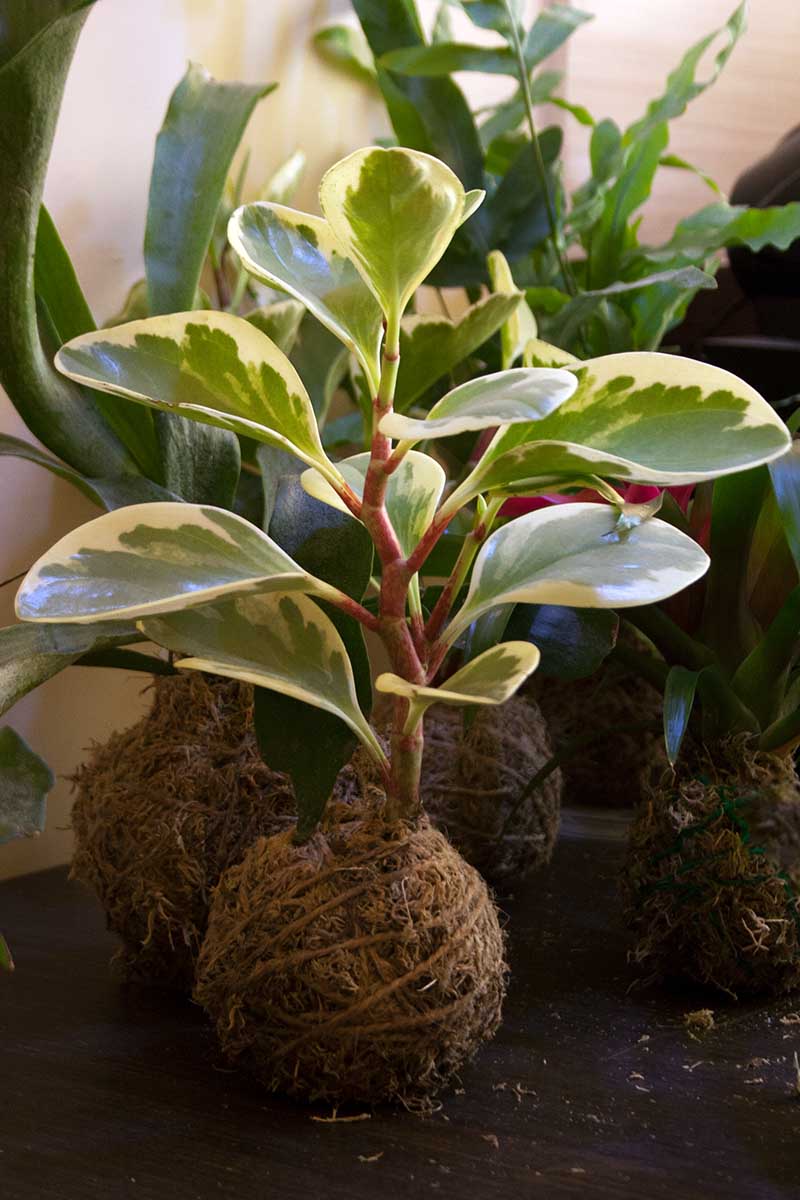
The ‘Marble’ cultivar has cream, dark green, gray, and white marbling. ‘Variegata’ has foliage with a white border, with dark and grayish-green mottling in the center.
‘Minima’ is a dwarf cultivar that never grows above a few inches tall.
If you’ve fallen in love with this P. obtusifolia, grab a species plant in a four-inch pot at Terrain.
If you prefer ‘Marble,’ Burpee has 10- 14-inch-tall live plants for sale.
10. Orba
If you need a little greenery for a small space like a corner of your office desk or on top of your bathroom cabinet, think petite pixie peperomia.
P. orba rarely grows taller than four or five inches, and while it can spread up to a foot wide, it will stay happily contained if you plant it in a smaller pot.
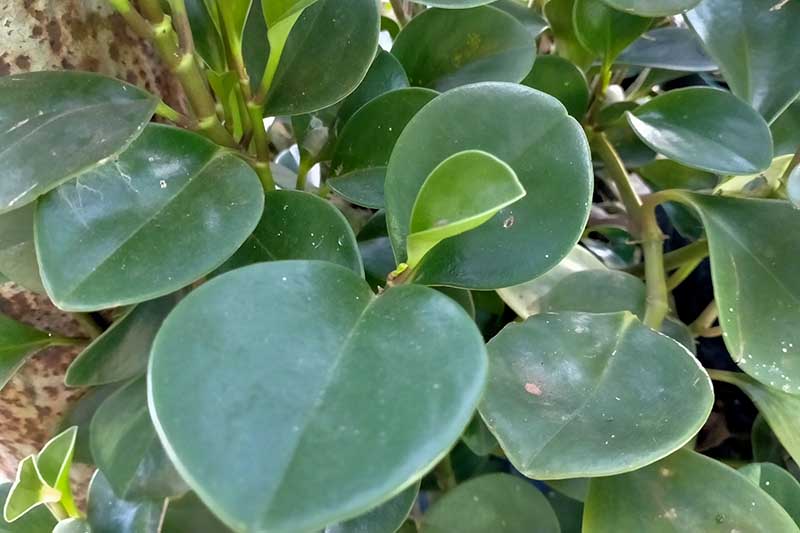
The leaves are thinner than those of many other species in the genus, but the stems are still thick and fleshy, providing for the water storage that’s characteristic of this group of plants.
The leaves are ovate and deep green with faint light green, almost invisible veins.
Another epiphyte, this Central and South American native will happily grow in soil as long as you don’t saturate the roots for long periods.
‘Variegata’ is a lovely variegated cultivar with creamy edges and irregular splotches.
11. Pellucida
Usually known as pepper elder or the shining bush, P. pellucida stands out because it is commonly cultivated as a vegetable in its native Brazil, and it has been studied for its numerous medicinal qualities.
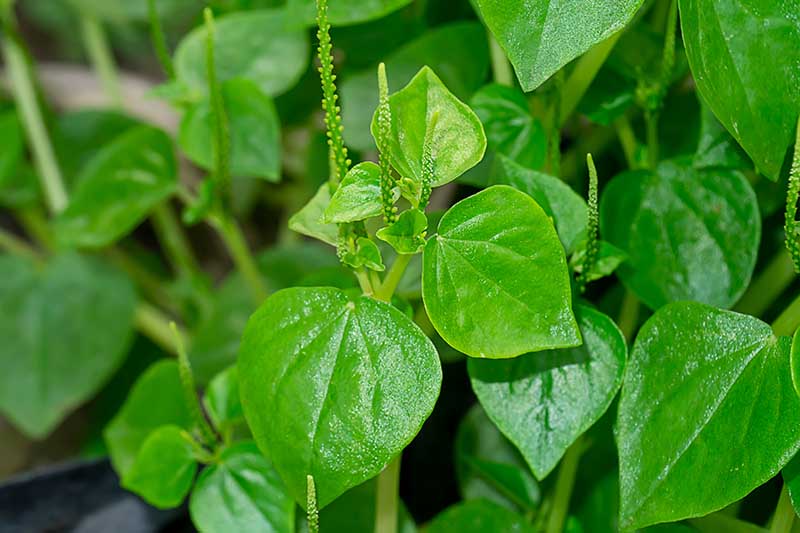
It’s known as coraçãozinho in Portuguese, which means little heart. As you might have guessed, the leaves are cordate, which means they have a heart-like shape.
If you crush the stem and leaves, they release a peppery, mustard-like scent. They, along with the roots, may be eaten raw or cooked.
Beyond being delicious, there is some evidence that this epiphytic herb might help to heal fractures and treat certain types of cancer, as well as acting as an antioxidant and antimicrobial.
12. Polybotrya
Raindrop peperomia has massive deep green leaves that have an elegant teardrop shape.
You could be forgiven for mistaking it for a Chinese money plant because these have a similar look, but make no mistake. Raindrop peperomias are their own unique animal… er, plant.
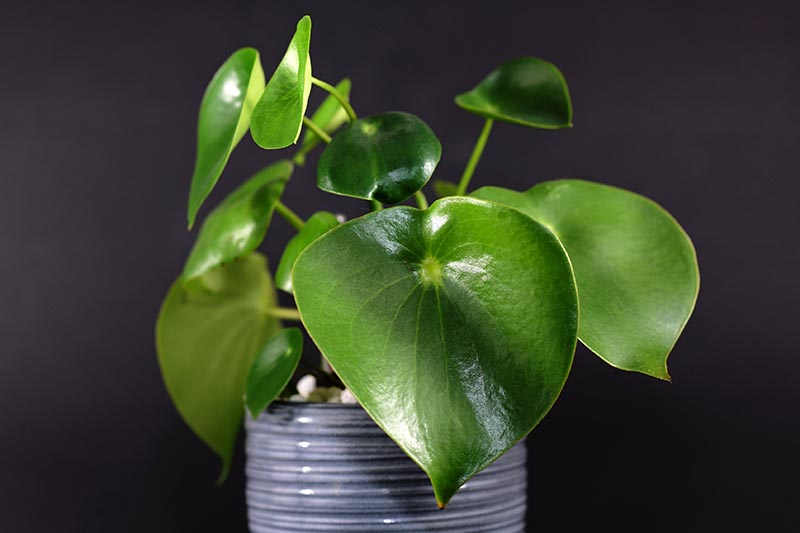
P. polybotrya is native to Columbia and Peru, and can grow up to 16 inches tall, though it will stay smaller in shadier conditions, and it’s a particularly slow grower.
One of the few species that isn’t an epiphyte, it does best with a nice loamy substrate.
13. Puteolata
Pretty parallel peperomia has leaves that resemble those of spiderworts (Tradescantia spp.). They are oval and come to a point, with a dark grayish-green base and gray vertical stripes.
P. puteolata has a semi-trailing growth habit. The stems are reddish, and grow up to 18 inches long.
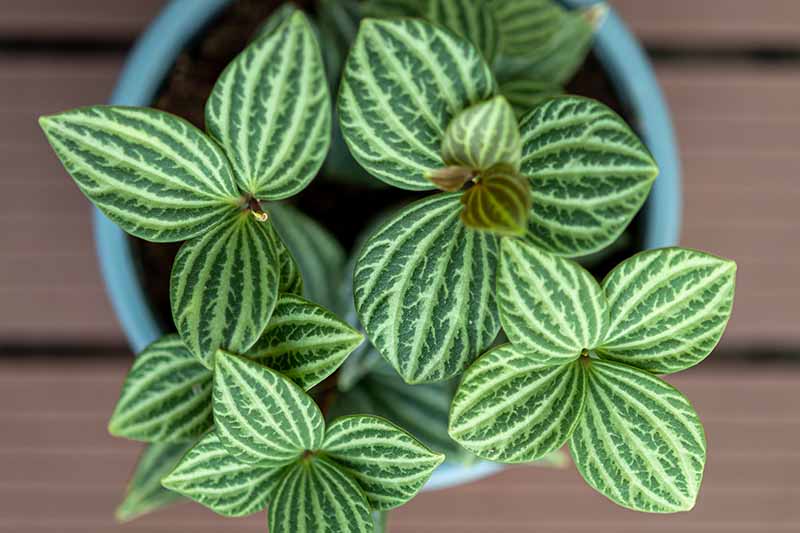
Another epiphyte, this pretty plant hails from South America, where it climbs up the mossy trunks of trees and shrubs.
14. Rotundifolia
Also known as ruby cascade, jade necklace, round leaf, or trailing jade, P. rotundifolia is absolutely smothered in tiny, thick, round jade-green leaves. If you look really closely, you can see the faint light green veins.
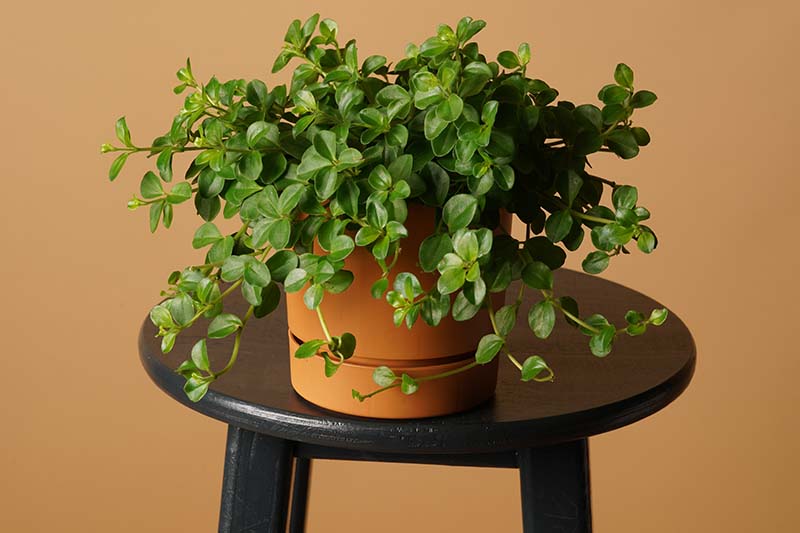
With its trailing growth habit and foot-long stems, it makes a particularly good option for growing in hanging baskets, or paired with an upright plant and allowed to trickle over the side of the container.
This epiphyte is native to tropical rainforest regions of South America, and can be challenging to find in some areas, so nab it if you come across it.
15. Scandens
P. scandens is sometimes called false philodendron peperomia, and it stands out because it crawls along the ground rather than standing upright. The leaves are heart-shaped and thick, and the stems are fleshy.
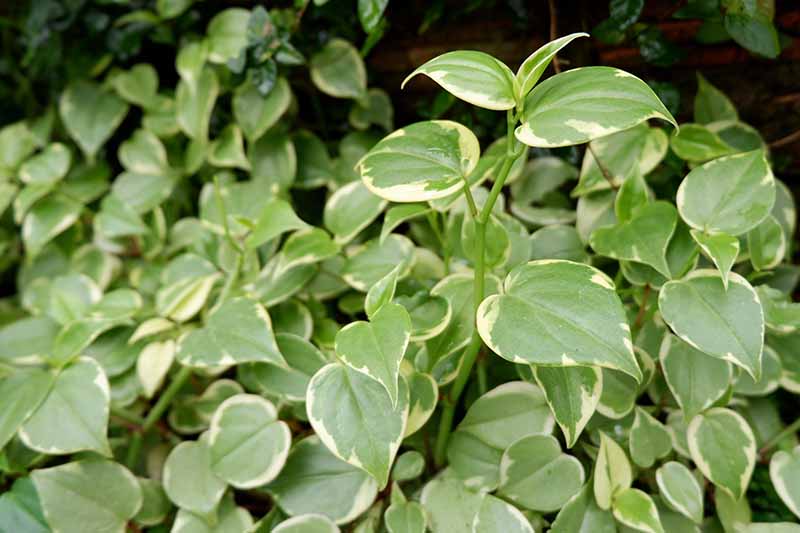
A vining epiphyte, native to South America, P. scandens can grow larger than many other species, and can reach up to three feet long and about a foot wide.
It’s extremely sturdy and tolerant of neglect. Just be sure not to put it in direct sunlight.
Keep an eye out for ‘Variegata,’ a cultivar of this species that is often featured in hanging baskets.
16. Tetraphylla
Acorn or four-leaved peperomia is a little bit misnamed. While the leaves sometimes grow in whorls of four, they can also appear in whorls of three. You could, however, call the leaves somewhat acorn-like, with their ovate shape.
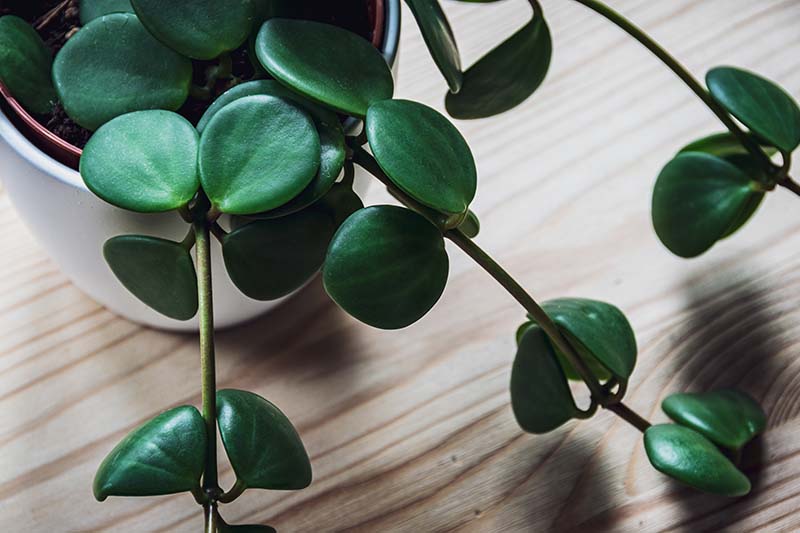
P. tetraphylla is native to Australia, Hawaii, New Zealand, and part of Africa and Asia.
The leaves of P. tetraphylla are small, medium green, and tinged with a faint red on the edges. It has a semi-creeping growth habit and it stays compact at somewhere between six and 12 inches tall and wide.
This epiphyte is a bit fussier than some others. It likes temperatures between 65 and 75°F, and it wants lots of sunlight – but no direct sun! The top inch of soil must be allowed to dry out between watering.
17. Wheeleri
Endangered in the wilds of its native Puerto Rico, Wheeler’s peperomia (P. wheeleri) can often be found in nurseries that specialize in rare and unusual houseplants.
This is one of the largest species out there, stretching up to three feet tall.
The fleshy lanceolate leaves are quite large for a peperomia, at nearly three inches long and two inches wide. Plants also send up masses of long, green flower spikes when grown in the right conditions.
It must be an impressive sight to see when this epiphyte clings to the mossy branches of a tree.
Peperomias Give You Plenty of Options
With all of the different shapes, sizes, growth habits, patterns, and textures of the many species of peperomias, it’s likely that there’s one that will catch your eye.
Whether you prefer the clean architectural simplicity of succulents or you want something with a lot of texture, plants in this genus can fit the bill.
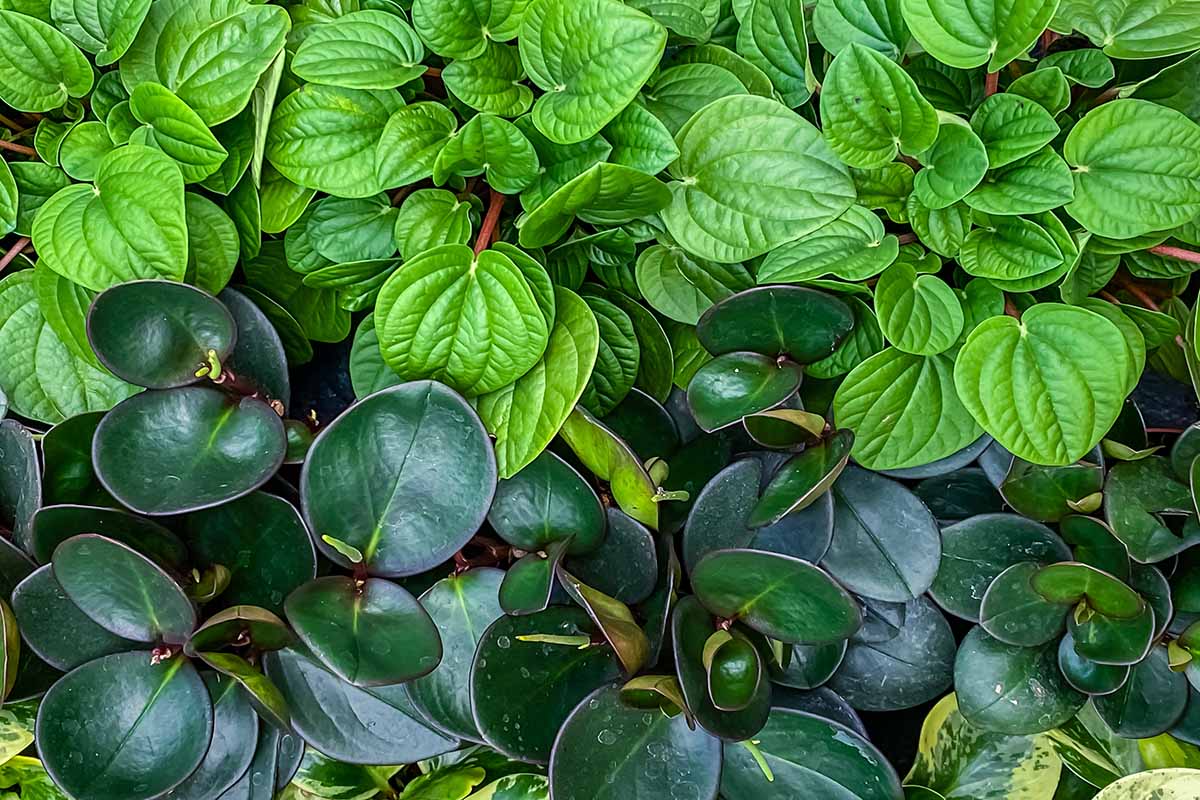
We can’t wait to hear which species draws you in. Be sure to come back and tell us the varieties you choose, in the comments below.
Once you start immersing yourself in the world of houseplants, it’s easy to become lost.
If you want a little more information on some other popular houseplants, we even more exceptional guides for you to read next, starting with these:
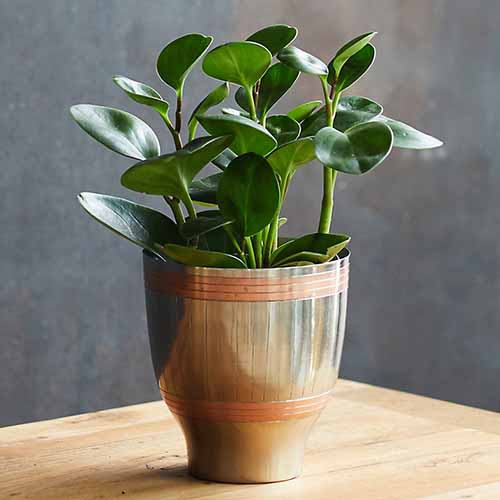

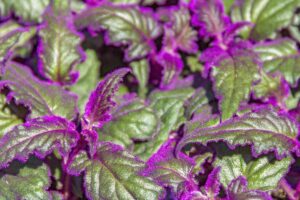
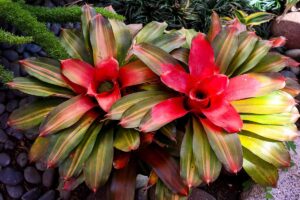
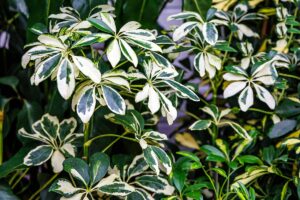
What is the peperomia that is in your main picture, in the bottom half, with thick, oval, dark green leaves?? I have that exact peperomia, but I don’t know exactly what variety it is.
Thanks!
Hey! That’s an obtusifolia cultivar, though I couldn’t tell you which one for sure. How large is yours? How wide across are the leaves?